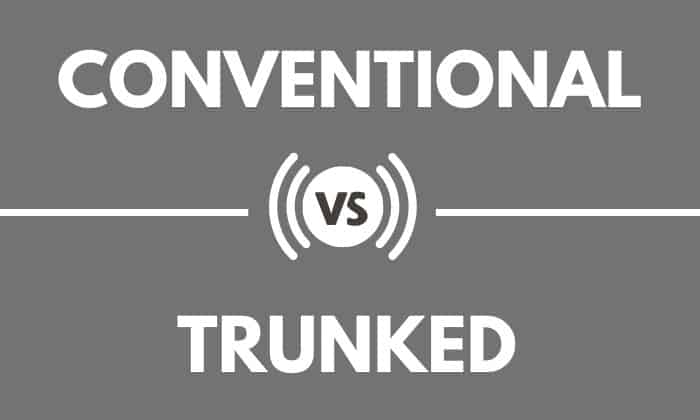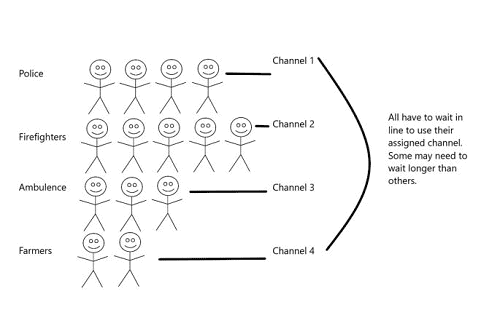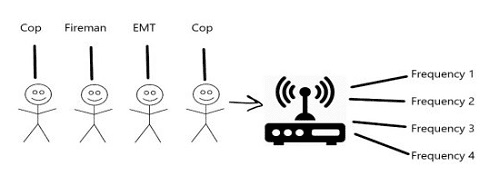Choosing the right two way radio can be overwhelming for a newcomer. It is because there are a series of different specifications that should be fitting to your needs. One of those choices to consider is what type of radio to use.
By that, this article will teach you the two general concepts that revolve around this topic. Continue reading to uncover the detailed comparison between conventional vs trunked radio systems.
Contents
What Are These Conventional and Trunked Systems?
1. Conventional radio system
The conventional radio system is the most basic or traditional type of radio communication system that is still used today. It has a technique that enables users to have one or more radio frequency channels. Also, for its sharing to happen, a station that repeats the radio transmission is required.
When you plan to use a channel within this network, you need to manually select them because this type of system does not automatically assign the vacant frequencies.
The main reason is that a channel in this system is equivalent to a radio frequency. And if ever the selected channel has an existing user, you need to fall in a queue before proceeding inside the system and using the desired radio frequency.
2. Trunked Radio System
A trunked radio system, on the other hand, is more advanced in a way that is more automated but more complex compared to a conventional one.
It is undeniably complex especially when setting up one and making a new program of automation of the vacant frequencies. But if your area already has a system, you only need a radio that is suitable for it.
Even though it is costly for some ordinary radio users, many people still utilize this because users here could listen to trunked radio frequencies with no delays.
Also, the number of spectral frequencies becomes higher when there are many users and unlike a conventional system, its channels do not equate the frequencies. Its channels are now computer-generated which are also known as talk groups.
Through a trunking scanner of the radios, people here are grouped automatically into “talkgroups” rather than being given a radio channel one at a time as is the case with other user groups. Also, trunked two way radio’s scanners have the ability to search and store those specified talk groups in a way like managing radio frequencies.
Today, digital trunked radio systems are commonly used because of their efficiency in which a lot of people can do various communications using only a few frequencies. An example of this is radios digital trunking police scanners which are not only used by the authorities but also used by citizens for different purposes like safety.
How Do These Two Work?
1. Conventional
This is the common type that has multiple channel networks which offer different functions in various areas. Police units may be on channel 1, firefighters may be on channel 2, etc. When utilizing one, you must manually choose a station by turning a radio dial or using a drop-down menu if you wish to speak with a certain group.
Also, its conventional communication allows users to only use one radio unit on every radio frequency making it kind of challenging to use. You need to patiently play a waiting game.
If you have tried falling in line and waiting for your turn to transact with something, then you just experienced the logic of this type of radio system. As shown in the sketch above, notice that every group does have a designated channel which may cause lags or delays due to its frequency-relying system.
2. Trunked
Together with its trunking frequencies list, this network is run by a computer that continuously links users to different radio channels as they become accessible.
It also has a method of increasing its transmission range by using repeaters that can receive and retransmit radio frequencies. In addition to that, it assigns the first open channel to each call made by a user of a trunked radio when they want to interact with another user or group.
To better understand this, the image above demonstrates how sorts of radio operators from various locations will be lined up when employing a trunking radio system. Every participant in the queue will be given a vacant frequency by it in the center. The automation made by the computer makes the allocations way quicker compared to the traditional ones.
Differences
1. Users Size
The first major difference between the two is the suitable users. Smaller groups should utilize the conventional one while the larger groups should be on the trunked systems.
2. Automation
The trunked system uses computer-generated assignment of the radio channels. While the traditional way needs to be manually modified.
3. Speed
Conventional systems usually have an instant calling and setting up time while the other is also fast but only takes a delay of not more than a thousand milliseconds.
4. Traffic Handling
The illustration below shows how conventional and trunked networks handle the traffic of people differently. No matter how many channels there are, the conventional system has the same capacity per channel. A trunked system’s per-channel capacity increases exponentially as the number of channels at a particular site increases.
Pros and Cons: Conventional
Pros
- Advantageous to users with small groups
- Can handle groups of users composed of not more than 70 each
- Instantaneous setup when dialing
- Can be used with no IP linkage
- There is an assigned radio frequency for each group of user
Cons
- Prone to users’ traffic
- Requires patience when lining up
- The quantity of frequencies in this system imposes a limit on this making it difficult to find frequencies, especially in more congested places.
- An FCC amendment is needed if you wish to use a different channel of communication route. So, there would be infrastructural expenditures if your agency decided to get another talk path.
Pros and Cons: Trunked
Pros
- Advantageous to users with big groups
- Suitable for workstations that need at least four channels
- Its channels are exponentially related to the number of user
- It has an automatic way of assignment of the available trunked radio frequencies
- There is no need to wait longer
Cons
- Costs up to three times more
- Needs an IP linkage
- Needs more budget if you aim for comparably large-sized systems. The same as the other one, it needs licenses for additional routes.
Is Trunking Better Than Conventional?
There is no better nor worse between the two because the answer to this question is very subjective to what you need and have. If you know that there are only a few users in your area, are on a budget, and have already considered the factors above, you may opt for a radio that is suitable for conventional systems.
Choose a trunking-compatible radio if you can afford it. You may also consider a terrestrial trunked radio that can offer a multitude of modern advantages, such as the ability to switch from a walkie talkie mode to a point to point mode during an emergency, which is not provided by traditional systems.
Also, when it comes to performance, efficiency, and scaling, Motorola trunked radio systems are your best bet. If you’re looking for large communications, you need immediate, dependable phone and data connections, improved perception, and seamless collaboration.
Conclusion
Now that you have learned all the details about conventional vs trunked radio systems, choose wisely what type of radio you should use. Make sure that it fits your needs while considering the other factors, especially the number of users you are in and your budget.
If you’ve successfully differentiated the conventional and trunked radio system explained in this article, you may share it with your colleagues or friends. Let them learn about this so that they could also experience a better radio usage experience.

Hello! I am Hart, the content writer and editor here at G0HWC. I used to be in the same local radio club with Howe, and he convinced me to join him in spreading my love for the radio with others. With a background in radio studies, I spend every day crafting accurate, easy to read content on various topics related to owning and using radios. I hope that my content can help you confidently venture in your radio journey!




